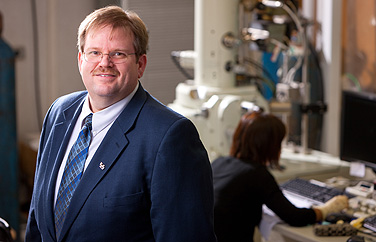Close Up
Cartwright leads UB’s research effort

After serving as a researcher, teacher and administrator since joining the UB faculty in 1995, Alexander Cartwright brings a comprehensive perspective of the university and its work to his role as vice president for research. Photo: DOUGLAS LEVERE
-
 Print
Print -
 Comments
Comments
-
“A goal of this office is to build more awareness with external entities of the excellent research being conducted at the university.”
As 2011 dawned, Alexander Cartwright officially became vice president for research after serving in an interim capacity since last July. He also has been serving as acting executive director of UB’s New York State Center of Excellence in Bioinformatics and Life Sciences since September.
These seem to be natural progressions for the electrical and biomedical engineering professor who, as vice provost for strategic initiatives from 2007-09, helped to build the university’s research infrastructure and foster collaboration across the multiple strategic strengths of the UB 2020 plan. Wearing many hats and winning many awards as researcher, teacher and administrator since his arrival at UB in 1995, Cartwright has a comprehensive perspective of the university and its work.
“Through some of my other roles, I’ve gotten to know faculty in many departments—from the sciences to the arts and humanities—and have become even further awed by the outstanding scholarship of the faculty in all areas of the university,” says Cartwright.
Improving faculty productivity is at the top of his list of goals, making it easier for members to pursue their objectives by providing the types of support they need to be successful. Closely following that priority are efforts to advance the university’s external reputation and increase research expenditures. Cartwright feels that while UB is highly competitive in acquiring research funding from state and federal funding agencies, such as the National Science Foundation and the National Institutes of Health, the university and its exceptional faculty don’t garner the national recognition they deserve.
“What that means to me is that some external people don’t really understand how good we are,” he says. “A goal of this office is to build more awareness with external entities of the excellent research being conducted at the university.”
Cartwright maintains a strong rapport and ongoing interactions with a wide range of faculty. “The research is the seed, the start of what makes an outstanding institution. It’s the research that allows us to then translate technologies into the community. As a research institution, it’s important that our faculty are research active—our national reputation depends on that. In addition, engaging in these research and creative activities gives faculty members a distinct perspective that allows them to do a much better job of teaching.”
Cartwright feels that the Center of Excellence—which officially opened in 2006 but goes back a decade in development—is progressing impressively and is at capacity in its building on the Buffalo Niagara Medical Campus. “It’s a great model as a shared facility servicing many faculty of different disciplines, from people doing fundamental science, to people whose work is more applied, to industry. What this allows is an opportunity for the fundamental science to be applied to real problems or devices.”
He acknowledges the Center for Computational Research as the anchor success story of the Center of Excellence. He cites the Hunter James Kelly Research Institute as having the potential to make a huge impact in terms of fundamental research in discovering ways to correct and treat the genetic defect responsible for Krabbe disease and associated brain disorders, and points to much activity in health care informatics, AIDS research and proteomics.
Cartwright’s hope for UB’s research future over the next five years would be to realize a significant increase in faculty productivity and funding, the latter a challenging goal especially in an environment where funding continues to be cut on a national level. “Significant increases may not be obtainable right away, but I believe that, given our excellent faculty, if we set the right things in place we will realize increases in productivity,” he says. “Longer term is more about improving our rankings. We’d like to be among the best of the AAU (Association of American Universities), a good place to be.”
Cartwright is a native of the Bahamas, where his family history dates to the 1700s. He eventually moved to the U.S. and was set to pursue a career in accounting until engineering proved to be an unexpected attraction. After graduating from the University of Iowa, he came to UB as a junior faculty member and found a home—not only at the university but in Buffalo.
“We had a 4-month-old daughter when we moved here,” he recalls. “A year-and-a-half later, we had our son. They grew up here and consider themselves Buffalonians. In terms of raising a family, you’re not going to find a better place than Buffalo.”
The UB 2020 vision of building research here to allow the local economy to flourish and keep area talent here is personal to him. “My daughter will be going to college in two-and-a-half years. Selfishly, you hope your kids will have an opportunity to have a career near where they are from or where you are. So, yes, we’d like to see that there are more opportunities for people in this area,” he says. “This area has people who are hard working, willing to put in the effort that’s needed for many projects. I think if we can provide the right environment for companies, including a talented workforce, they’ll start to see that there is a tremendous amount of talented people in this region to keep them here.

Reader Comments